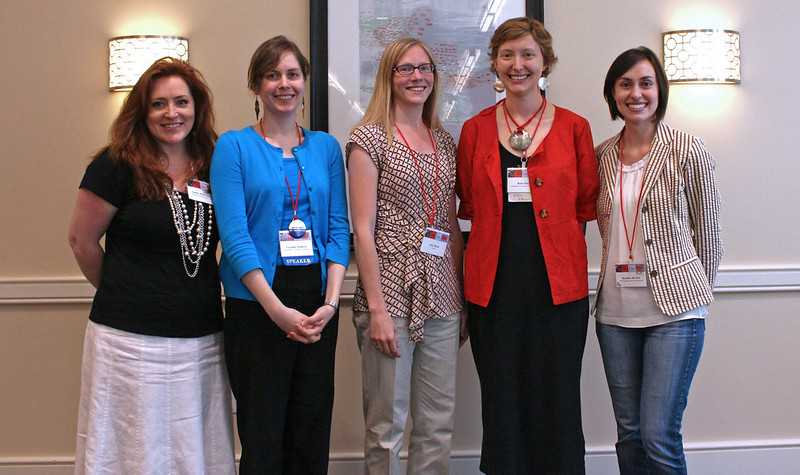

“The Next Chapter: Rare Books in Modern Times” conference had an ambitious goal, to offer talks of benefit to anyone with a professional interest in rare books. The conference was presented by the Conservation Center for Art and Historic Artifacts, and hosted by the American Philosophical Society in Philadelphia.
One of the aspects I most appreciated about “The Next Chapter” was the collaborative spirit fostered by having speakers from a diversity of rare book-related professions. Librarians, preservation administrators, conservators, a curator, and a professor of book arts shared their expertise and insights with an audience of more than 100 rare book professionals and students. The presentations ranged from practical preservation basics to inspiring achievements in conservation, digitization, and exhibition methods.
Chela Metzger, Conservator of Library Collections at the Winterthur Museum, gave an overview of contemporary rare book conservation and a brief historical perspective of book conservation. She discussed collaborative digitization and public engagement projects involving conservators and other professionals.
Abigail Quandt, Senior Conservator of Manuscripts and Rare Books at the Walters Art Museum, presented the historical evolution of codex bindings from Coptic Egypt through the early European Renaissance, and some examples of later handwritten Eastern Mediterranean books.
For altered or damaged rare manuscripts, digitization methods may help to reveal the original text and page order. Will Noel, Director of the University of Pennsylvania’s Special Collections Center and The Schoenberg Institute for Manuscript Studies, discussed the challenges of digitizing and conserving the Archimedes Palimpsest and three other Byzantine manuscripts.
Not all rare books were originally ornate or expensive. Renée Wolcott, Book Conservator at CCAHA, discussed the construction, history, and preservation challenges for the simple, inexpensive American scaleboard bindings of the mid-17th to early 19th centuries.
Jim Hinz, CCAHA’s Director of Book Conservation, spoke about projects that combined book conservation and digital imaging, including the preservation of Bruce Springstein’s original spiral-bound notebooks of lyrics.
For those seeking basic how-to information, Janet Gertz offered two talks on setting preservation priorities and selection for digitization. She is the director of the Columbia University Libraries Preservation and Digital Conversion Division.
Maria Fredericks, Drue Heinz Book Conservator at the Morgan Library & Museum, discussed her institution’s impressive state-of-the-art exhibition program.
Public outreach is an important focus for rare book collections. Christine Nelson, Drue Heinz Curator of Literary and Historical Manuscripts at the Morgan Library & Museum, presented digital strategies to engage the public, educate, and inspire dialogue about special collections.
Eric Pumroy, Director of Library Collections and Seymour Adelman Head of Special Collections for Bryn Mawr College, spoke about ways of promoting and preserving rare book collections, including the use of social media, adopt-a-book programs, exhibits about conservation, and recognition of donors.
In his talk about the University of Alabama’s hands-on MFA book arts classes in Cuba, Professor Steve Miller shared the joy of creation, and a welcome perspective from contemporary makers of hand-crafted, limited edition books. Miller is the Coordinator of the MFA in the Book Arts Program, School of Library Sciences, for the University of Alabama.
Conference participants were invited to attend two optional events, an open house reception at the Conservation Center for Art and Historic Artifacts, and a rare books talk in the American Philosophical Society’s reading room by Roy Goodman, Assistant Librarian and Curator of Printed Materials. At the reception, CCAHA staff discussed their current conservation treatments and storage housing projects.
The diversity of subjects and perspectives presented during the talks ensured that there was something of interest for everyone. We learned from each other and gained a better understanding of other aspects of the field. “The Next Chapter “ was an inspiring and valuable conference.









